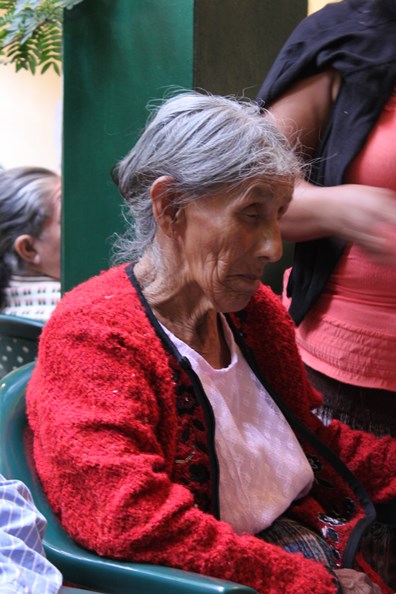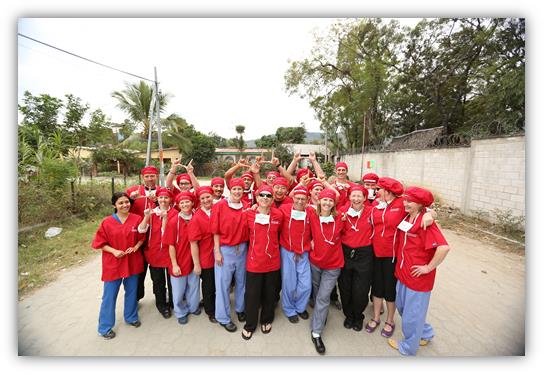Breadcrumb
What does a week at an outreach medical eye camp look like?
The Moran Eye Center Outreach team returned Sunday from a mission to Salama, Guatemala a region with 800,000 people and only one ophthalmologist. While there, the all-volunteer group performed over 100 sight-restoring surgeries and trained staff at the local Lions eye hospital in how to provide the best possible eye care.
Day 1
Before the driver can turn off the engine, the team is off the bus and unloading medical supplies. It's an orderly process: A single-file line forms, and each person steps forward to receive an equipment bag. As the final duffels are carried in, the operating room team begins tearing down the existing clinic. They move tables, clear shelves, and relocate equipment. They want a clean canvas for their surgical supplies, operating tables, and microscopes. The pace is frenetic and the mantra is "keep up or go home."
But setting up an outreach camp is more than a hard day's work. Labor alone can't transform a small Lions eye hospital in Salama, Guatemala from a rural clinic to a sterile, state-of-the-art surgical suite. The Moran Eye Center Outreach team has spent months planning this trip. Before the week's end, they will restore sight to more than 100 patients a feat made possible by Moran's many dedicated professionals who have spent years creating and refining best practices for delivering care to remote and underserved regions. In Salt Lake City, Utah, the support of dozens of volunteers and hundreds of donors have made this mission, and others like it, possible.
Watch a video of the team's first day.
Day 2
Shuffling backwards, Lucia Pasqual glances over her shoulder as she leads her mother by both hands into the clinic. Local Lions Clubs have spread the word that Moran's surgeons are in Salama, and Lucia has brought her mom, blind in both eyes, for help. Like most of the patients, her mother has cataracts from years working the fields under the intense sun. Her family worries that her mom will fall or hurt herself, so Lucia has quit work to care for her. The family is now down two incomes.
All morning, a steady stream of patients arrives. Most have blinding cataracts in both eyes. They are brave and trusting as their family navigates the organized chaos, leading them from check in to scans and measurements, to registration and lens selection, to dilation, blocks, and surgery. The team completes 34 surgeries.
Day 3
 Still wearing his post-surgical eye shield, Santiago (pictured left) is carefully guided by his daughter to a seat in the waiting room. His head hangs and his expression is empty. Santiago has been completely blind for years; he is used to a world without sight. As the medical team works its way down the line of post-operative patients, Santiago waits patiently to have his patch removed. At last, he is instructed to lift his head, and a volunteer gently pulls the tape from his brow and his eye patch falls. Santiago stares vacantly for a minute before blinking and moving his eye. Slowly, he turns toward his daughter and smiles. She laughs and smiles back. Santiago can see! When asked what they are looking forward to now that his vision is restored, they both say freedom. The family is free from the burden of having to care for him and Santiago is free to return to the fields to work. Today, the team restores sight to 37 patients.
Still wearing his post-surgical eye shield, Santiago (pictured left) is carefully guided by his daughter to a seat in the waiting room. His head hangs and his expression is empty. Santiago has been completely blind for years; he is used to a world without sight. As the medical team works its way down the line of post-operative patients, Santiago waits patiently to have his patch removed. At last, he is instructed to lift his head, and a volunteer gently pulls the tape from his brow and his eye patch falls. Santiago stares vacantly for a minute before blinking and moving his eye. Slowly, he turns toward his daughter and smiles. She laughs and smiles back. Santiago can see! When asked what they are looking forward to now that his vision is restored, they both say freedom. The family is free from the burden of having to care for him and Santiago is free to return to the fields to work. Today, the team restores sight to 37 patients.
 Day 4
Day 4
Patients and their families are crammed in the clinic. Busloads have arrived from Coban, a rural village eight hours away. Others have come by cart and oxen. Marta Morente Ixcopal has used the family's savings to hire a taxi to bring her mother, Cornelia, for surgery. Cornelia (pictured right) is deaf and blind and must be carried everywhere. Marta does not know where they will stay for the night, but she trusts there will be help. She is right. The local Lions Club has arranged for patients who have traveled far distances to stay in the locker room of a nearby soccer stadium, where they will be fed and given bedding. Tara Kisow, a member of the Outreach team, likes to say that "You're only as good as your partners on the ground." She is right. Today, the team completes 35 surgeries.
Day 5
Today there are tears. Cornelia's daughter, Marta, waits anxiously for Cornelia's patch to be removed. Yesterday, the doctors told her there is nothing they can do for her mother's right eye– the damage is permanent; but they operated on the left eye hoping to restore partial vision. When the patch comes off, Cornelia struggles to open her eye. She is stoic, and it is unclear if the surgery has worked. Marta asks if she can see, and Cornelia nods. She can perceive light. The doctor comes. He tells them the surgery was successful and she should gradually start to see more. They wait quietly for the taxi that will take them home. When it arrives, Marta prepares to lead her mom out of clinic, but Cornelia waves her off. She wants to walk on her own. Mother and daughter both start crying. Cornelia is seeing! They hug each other and the Moran staff. Then, side by side and hand in hand, they walk to their taxi. "Thank you, thank you," they say the entire way.

The John A. Moran Eye Center would like to say thank you as well to the donors, volunteers, and medical partners who make this work possible. Thank you for giving the gift of sight!